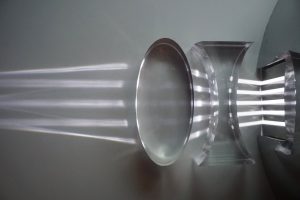Key Takeaways
- Spherical mirrors, including concave and convex mirrors, have curved reflective surfaces that create real images by converging parallel rays to a focal point.
- Depending on object placement, concave mirrors produce inverted real images that vary in size at the focal point or between the center of curvature and focal point.
- Convex mirrors reflect light to create virtual images, with parallel rays appearing to diverge from a virtual focal point, resulting in images that are upright and reduced in size.
- Convex mirrors are used for wide-angle viewing, such as in security mirrors, and adhere to factory standards including specific diameter tolerances, surface flatness, surface quality, and clear aperture requirements.
Understanding Concave and Convex Mirrors in Spherical Mirrors
Mirrors can either have a plane surface or a curved surface. These two surfaces correspond with two types of mirrors, respectively: a plane mirror or a spherical mirror. Plane mirrors have a flat reflective surface and reflect light without distorting the image. It follows the law of reflection, which states that the angle of incidence is equal to the angle of reflection. On the other hand, spherical mirrors have curved reflective surfaces.
Spherical mirrors can be broken down even further into two types: concave and convex mirrors. Before diving into the types of spherical mirrors, it’s important to understand a few basic terms.
- Pole: The central point on a spherical mirror. It is the midpoint of the mirror’s reflective surface and is located on the principal axis. It is denoted with the letter “P”.
- Center of Curvature: The central point along the principal axis of a spherical mirror. At that point, it has the same tangent and curvature. It is denoted by the letter “C”.
- Radius of Curvature: The distance from the pole of the spherical mirror to its center of curvature. It is denoted by the letter “R”.
- Principal Axis: An imaginary line passing through the center of curvature and the pole of a spherical mirror. It serves as a reference line for describing the geometry of the mirror.
- Principal Focus “Focal Point”: The point on the principal axis where parallel rays of light either converge (for concave mirrors) or diverge from (for convex mirrors) after reflection. It is denoted by the letter “F.”
- Focus: Any given point on the principal axis where parallel rays meet. The rays will either converge or diverge after reflection, depending on the type of spherical mirror.
- Aperture: The diameter of its reflective surface through which the reflection of light occurs. It is also the maximum width of the mirror, and is measured perpendicular to the principal axis.
Types of Spherical Mirrors
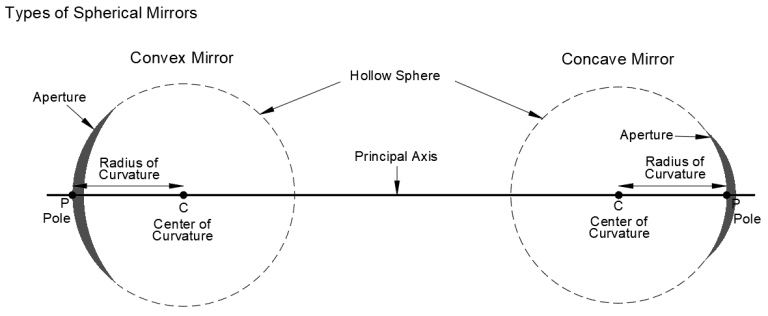
Concave Mirrors
Concave Mirrors are spherical mirrors with a reflective surface that curves inward. It resembles the inner surface of a sphere. Concave mirrors are also called converging mirrors since the rays of light converge when it strikes the mirror’s surface. The point where the parallel rays converge is the focal point.
Characteristics of Concave Mirrors
Depending on where the object is placed in front of a concave mirror, the image’s location, orientation, size, and type will all be different. There are 5 main cases:
- The object is located behind the Center of Curvature “C”: If the object is positioned behind the Center of Curvature “C” of a concave mirror, a real image will form between the Center of Curvature “C” and the Focal Point “F”. The image will be inverted and reduced in size.
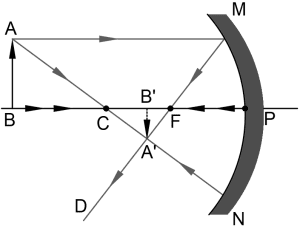
2. The object is located at the Center of Curvature “C”: If the object is positioned at the Center of Curvature “C” of a concave mirror, a real image will form at the Center of Curvature. The image will be inverted and maintains the same size as the object.
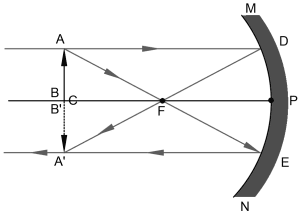
3. The object is located between the Center of Curvature “C” and the Focal Point “F”: If the object is located between the Center of Curvature “C” and the Focal Point “F”, a real image will form behind the Center of Curvature. The image will be inverted and enlarged in size.
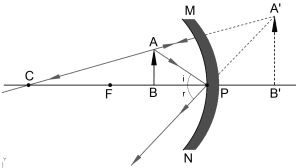
4. The object is located at the Focal Point “F”: This is a bit of a peculiar case where there is actually no image that forms. This is because the reflected rays from the object are parallel after reflection, and they do not converge to form a real image. The reflected rays appear to diverge as if coming from the focal point behind the mirror. Thus, the image is considered “at infinity”.
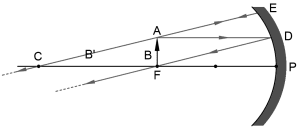
5. The object is located in front of the Focal Point “F”: If the object is located in front of the Focal Point “F”, a virtual image will form behind the mirror. The image will be upright and enlarged in size.
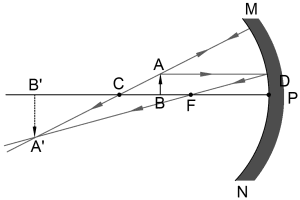
Convex Mirrors
Convex Mirrors are spherical mirrors with a reflective surface that curves outward. It resembles the outer surface of a sphere. Convex mirrors mirrors are also called diverging mirrors since the rays of light diverge when it strikes the mirror’s surface. The point from which the diverging rays appear to originate is known as the virtual focal point.
Characteristics of Convex Mirrors
Unlike for concave mirrors, the image will always virtual, upright, and reduced in size no matter where the object is placed in front of the mirror. Unlike concave mirrors, convex mirrors do not have a real focal point. Parallel rays diverge upon reflection but do not converge to a specific point. Convex mirrors provide a wide field of view, making them suitable for applications such as security and surveillance mirrors.
Factory Standards
Diameter | +0, -0.1mm |
Surface Flatness | λ/4 |
Surface Quality | 40-20 |
Clear Aperture | >90% diameter |
GREAT ARTICLE!
Share this article to gain insights from your connections!




